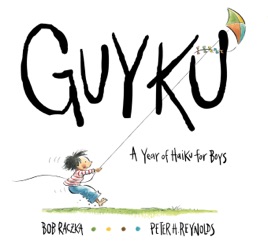Hello everyone, it looks like we have to stay at home a little longer than expected. On a positive note, we have more time to reflect, and spend time with those that we love. Of course, this gives us more liberty to read precious books!
Today, I would like to share with you two poetry books. I have enjoyed reading these books word for word. I know that I have previously mentioned my heart favoring mystery, and historical fiction, but poetry also has a special habitation too.
Guyku, is a poetry anthology book, written by Bob Raczka, and illustrated by Peter H. Reynolds. This anthology contains Haiku poems, whose target audience is boys. Haiku poems are known for their Japanese inheritance.
Haikus contain three lines. They are short form poems, which utilize five syllables in the first line, seven syllables in the second line, and five syllables again in the last line. Bob Raczka is very clever in his writing. He makes sure to not only include different seasonal changes, but also incorporates the playful games that boys play. Rackza wrote his Haikus in present tense, in order to make them more appealing to boys.
The poems transition brilliantly, and were meticulously planned. In his poems, the author makes sure to emphasize his experience with nature, and shares games that he used to play. His poems contain a vast amount of scrumptious adjectives, and profound vocabulary.
Peter H. Reynolds exhibits whimsical creativity in his art. Reynolds is known for his book called, The Dot. He shares that he wants to defy stereotypes through his art, and inspire children to think creatively and bravely. His art reminds me of detailed cartoon characters, which are brought to life in old newspaper comic strips. Without a doubt, his illustrations give exceptional meaning to the text. Reynolds' penciled doodles display movement. He includes a lot of warm earth tones. Peter H. Reynolds uses a variety of things to paint with. Gouche is his favorite. It is opaque enough to construct lighter colors above darker ones. He uses anything wet such as: tea, soda, milk, and even the dew from blades of grass.

Fall Leaves, is a picture book written by Loretta Holland, and illustrated by Elly MacKay. Loretta Holland wrote poems that express the different changes that happen within fall itself. Her poems give readers a special sense of imagination. Holland's poems give a modern take of poetry, by including geography, and direction. This book is a perfect model for teaching descriptive writing in the classroom. She takes readers through a venture of activities that happen during fall.
Elly MacKay is a genius! This artist creates her illustrations piece by piece, by making a miniature theater. Her picturesque drawings are so life like! She made sure to include realistic shadows on the ground, and accurate reflections on bodies of water. The hues in her illustrations hold bright sunny golds, crisp autumn oranges, and various pleasant browns. The characters actions display a starry-eyed nostalgia. The romantic sights most definitely draw me in. Do not forget to partake of the fall activities at the end of the book!
Being Mindful,
Evelyn Portillo <><











